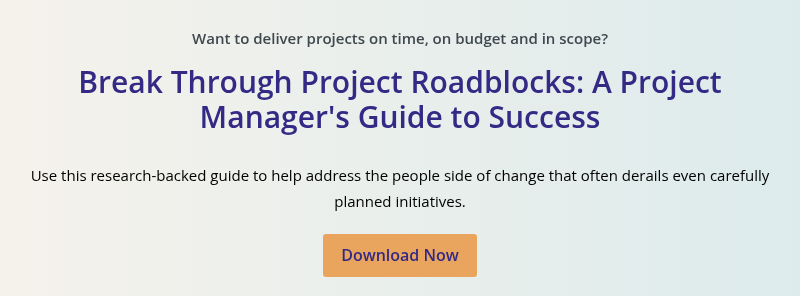Why is Change Management Important for Program Management?
6 Mins
Updated: August 19, 2025
Published: May 10, 2023

Today, many organizations are embarking on more complex, interdependent and technically challenging change programs than they have undertaken previously. And because project teams are under pressure to roll out multiple urgent changes, they often bypass best practices—creating the potential for projects to collide both on the technical side and the people side. Managing changes with a program-level perspective addresses these issues and more.
What Is Program Management?
Organizations with mature project management functions manage related projects by grouping them together as a program, coordinating efforts to achieve additional benefits like lower costs, and greater control and efficiency. Not to be confused with portfolio management—which focuses on strategic management of all projects, programs, subprograms and operations—a program of interdependent projects delivers a single set of benefits.
Examples of change programs we see today include:- Digital transformation – comprising ERP implementations, digitization, and hybrid working models designed to enable greater organizational efficiency and agility
- Sustainability – made up of energy efficiency, circular economy, recycling, and culture projects intended to reduce carbon intensity or grow more sustainable as an organization
- New operating model – including organizational and service redesign, training, recruitment, and IT projects focused on transitioning to the new organizational model
- Culture change – such as DEI, employee experience, recruiting, training, and other projects intended to regain or develop a people-focused culture

Change Management at the Program Level
The danger of managing all those individual projects without a program-level perspective is that organizations miss the broader considerations of timing, interdependencies, aggregate risk, resource constraints, the overall budget for the program, and so on. Adding a program layer of governance, roles, practices and routines ensures an overall strategic perspective on a program of projects. A program management perspective has significant implications for change management and vice versa.
Although every organization is unique, we see two common scenarios:
- Organizations recognize the differences between projects and programs, but they lack program management capability.
When implementing projects, project managers naturally tend to focus on their individual pieces of work. Projects may operate as silos with limited appreciation of their interdependencies and impacts until issues start accumulating on project RAID logs (a tool for tracking risks, actions, issues and decisions). This complicates change management and puts the success of the program and its component projects at risk.
For example, you may not fully understand the cumulative impacts on groups or the organization as a whole. You could also miss the aggregate people-side risk of multiple, interdependent projects in flight at one time. - An organization invests significantly in developing project management capabilities at program levels but change management capability lags.
Although organizations increasingly begin their journey to build change management capability with a small number of demonstration projects, we are increasingly seeing transformation programs acting as the catalyst to begin the journey.
While the starting point may differ, you can address both of these scenarios by deploying change management at the program level, as well as on each individual project.
Programs vs. Projects
| Projects | Programs | |
| Characteristics |
|
|
| Projects | Programs | |
| Management Focus |
|
|
How to Integrate Program Management
and Change Management
You can ensure this strategic focus on programs by paying attention to the five key areas recommended by the Project Management Institute’s Standard for Program Management: strategy alignment, benefits management, stakeholder engagement, program governance and lifecycle management.
1. Strategy alignment
This is about making sure that all projects in the program, as well as the program itself, clearly align with the organization’s strategy. The program’s expected goals and benefits must also tie in with the organization's overall strategic goals and objectives. After that, the business cases, program roadmap, risk management, and other key aspects of the program require a change management perspective.
Organizations are reporting to me that they're overwhelmed by change over the last couple of years, and they’re seeing increasing change fatigue. And yet, many organizations are implementing digital transformations. When considering the business case for transformation, are you looking through the change management lens in terms of readiness impacts and resistance capacity? And are you bringing that into the conversation early enough?
If you start by defining projects and charters for individual projects without knowing whether there is a business case for the program as a whole, change management is often ignored or called in too late to have a strong impact. Consider how you can bring a change management lens to project appraisal, selection and prioritization during the program definition phase.
2. Benefits management
From a project and program management perspective, organizations have been emphasizing benefits management increasingly over the last decade or more. But organizations overall still think “installation equals success.” Change managers need to call out both the program's dependence on people as well as the project’s dependence on people by assessing risk for both.
When planning your program and identifying the component projects, you want to consider all benefits. What does adoption and usage look like in terms of each? Benefits mapping is a helpful tool to visualize and align around how component projects build towards a single set of people-dependent benefits. As your program progresses, pay attention to aggregate adoption-and-usage metrics across the program. Later, as you gather data on sustainment of benefits achieved at the individual project level, be sure to aggregate the data at the program level to gain insights
3. Stakeholder engagement
Strategic engagement for the program differs from stakeholder engagement for individual projects. For example, when you assess both, you might learn that four projects are going to send surveys in the first quarter to the same impacted groups, which is a lot in a short period of time. That won’t land well with people. A program-level perspective to change management looks for opportunities to aggregate and streamline activities to understand the effectiveness of stakeholder engagement at the program level as well as with individual component projects.
4. Program governance
First, consider whether you are putting in place the right policies and practices. Do you have a consistent language, methodology and toolkit for change management within the program, or is everybody using their own homemade approach? Do you have consistency in people-side reporting data and insights? Is there a change management lens being brought to bear in governance decisions at the program level?
For example, with program assurance, you’re doing health checks on quality assurance outputs from different projects, looking at how the project is performing within the program. Are you looking through the change management lens in that work, or are you purely focused on the quality and benefits from the technical-solution side of the equation?
The same is true of structure, and roles and responsibilities. If you're have a program management layer, you're likely going to have a program office with a program manager who oversees individual project managers. Is there a change practitioner involved? Where do the change management resources sit? What kind of role, structure and governance design will be put in place to support the program from the people-side perspective? What people-side acceptance criteria are in place when closing individual projects and the program as a whole? How do you know when you’re done?
5. Lifecycle management
If you have 100 projects to deploy over the next five years, you want to break them down into tranches or waves, deploying a set number per timeframe. Then, consider both the lifecycle of each individual project and that of each tranche within the program. Are you bringing in change management to understand levels of impact, resistance, change saturation and collision? Are you discussing the technical dependencies, the intended benefits you hope to achieve, and the strategic goals you are trying meet? How will you factor the above into your selection, prioritization and timing of the component projects in each tranche?
Be sure to define each lifecycle through a change management lens. When you get to the end of a tranche, you should measure success of change management. And before greenlighting the next tranche, you need to see sustainment from the previous tranche before moving on. Do you have a change management plan for the next tranche? Effective change management enables strategic conversations around timing of projects when they sit in a particular tranche and when you move from one tranche to another.

Actions to Address Change Management Challenges in Program Management
Managing program-level changes effectively depends on your unique organization’s project management, program management, and change management maturity. And some organizations today are standing up all three functions at the same time, which is quite complex. As a starting point, you can improve your odds of success if you:
- Bring change management into the conversation early, ideally when developing the business case. Be sure to tie people-side benefits to program benefits.
- Define project and program-level benefits clearly at the outset of the program. Be sure to clearly define roles and responsibilities of project managers, program managers and change managers, and how these roles will work together.
- Adopt a consistent change management language, methodology, process and toolkit throughout the organization.
- Aggregate risk assessments, adoption-and-usage metrics, people-side impacts, saturation levels, stakeholder engagement plans, etc. at the program level as well as at the individual-project level, where appropriate.
Deploying Change Management
at the Program Level
How change management integrates with program management depends to a degree on the level of program management maturity in the organization. Your organization must first make a clear distinction between deploying projects and programs, and avoid treating a program like one big project. Then, you will be positioned to present your organization with a clear plan for the change management work required for success at both levels.




